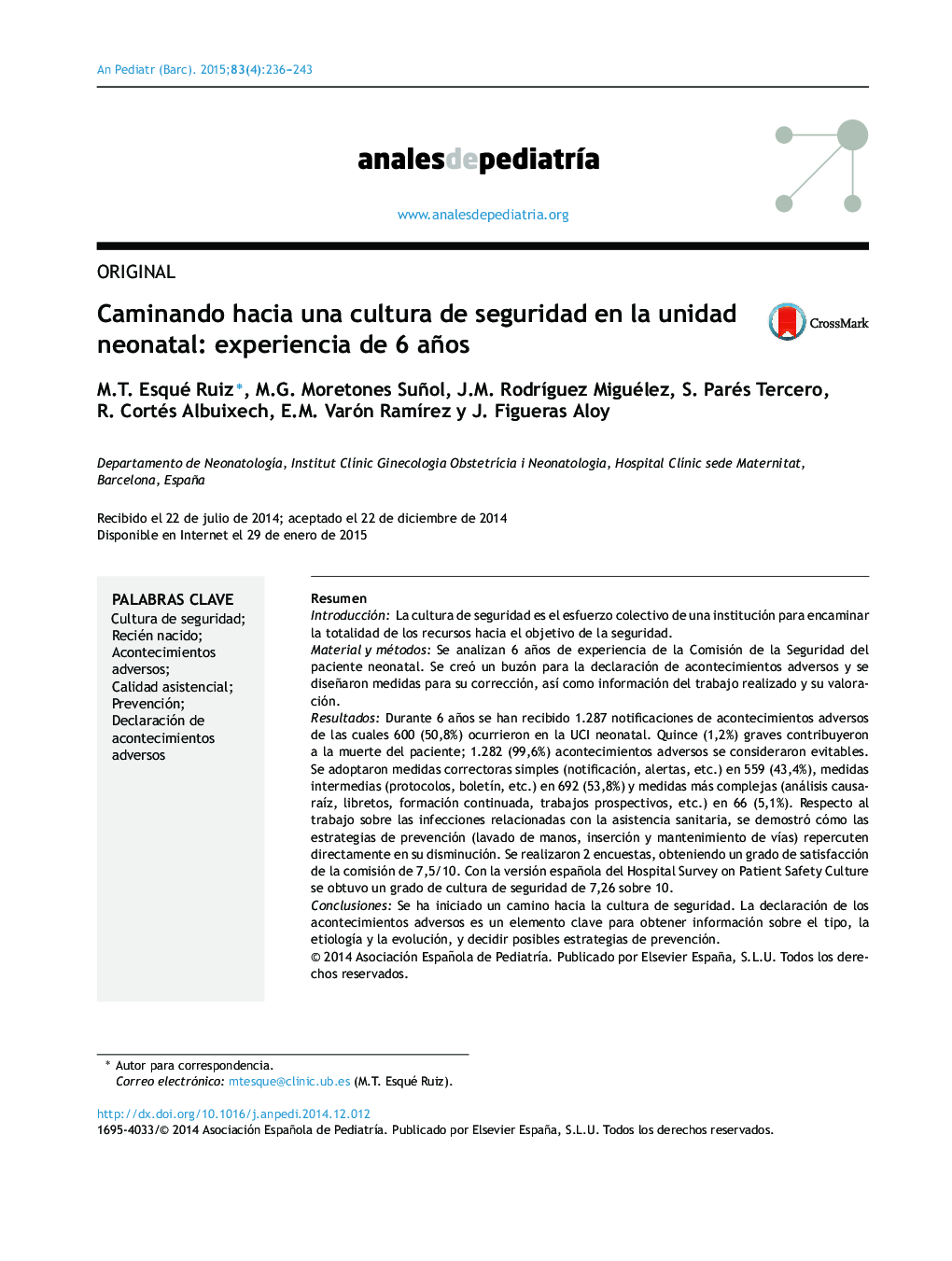| کد مقاله | کد نشریه | سال انتشار | مقاله انگلیسی | نسخه تمام متن |
|---|---|---|---|---|
| 4141068 | 1272315 | 2015 | 8 صفحه PDF | دانلود رایگان |

ResumenIntroducciónLa cultura de seguridad es el esfuerzo colectivo de una institución para encaminar la totalidad de los recursos hacia el objetivo de la seguridad.Material y métodosSe analizan 6 años de experiencia de la Comisión de la Seguridad del paciente neonatal. Se creó un buzón para la declaración de acontecimientos adversos y se diseñaron medidas para su corrección, así como información del trabajo realizado y su valoración.ResultadosDurante 6 años se han recibido 1.287 notificaciones de acontecimientos adversos de las cuales 600 (50,8%) ocurrieron en la UCI neonatal. Quince (1,2%) graves contribuyeron a la muerte del paciente; 1.282 (99,6%) acontecimientos adversos se consideraron evitables. Se adoptaron medidas correctoras simples (notificación, alertas, etc.) en 559 (43,4%), medidas intermedias (protocolos, boletín, etc.) en 692 (53,8%) y medidas más complejas (análisis causa-raíz, libretos, formación continuada, trabajos prospectivos, etc.) en 66 (5,1%). Respecto al trabajo sobre las infecciones relacionadas con la asistencia sanitaria, se demostró cómo las estrategias de prevención (lavado de manos, inserción y mantenimiento de vías) repercuten directamente en su disminución. Se realizaron 2 encuestas, obteniendo un grado de satisfacción de la comisión de 7,5/10. Con la versión española del Hospital Survey on Patient Safety Culture se obtuvo un grado de cultura de seguridad de 7,26 sobre 10.ConclusionesSe ha iniciado un camino hacia la cultura de seguridad. La declaración de los acontecimientos adversos es un elemento clave para obtener información sobre el tipo, la etiología y la evolución, y decidir posibles estrategias de prevención.
IntroductionA safety culture is the collective effort of an institution to direct its resources toward the goal of safety.Material and methodsAn analysis is performed on the six years of experience of the Committee on the Safety of Neonatal Patient. A mailbox was created for the declaration of adverse events, and measures for their correction were devised, such as case studies, continuous education, prevention of nocosomial infections, as well as information on the work done and its assessment.ResultsA total of 1287 reports of adverse events were received during the six years, of which 600 (50.8%) occurred in the neonatal ICU, with 15 (1.2%) contributing to death, and 1282 (99.6%) considered preventable. Simple corrective measures (notification, security alerts, etc.) were applied in 559 (43.4%), intermediate measures (protocols, monthly newsletter, etc.) in 692 (53.8%), and more complex measures (causal analysis, scripts, continuous education seminars, prospective studies, etc.) in 66 (5.1%). As regards nosocomial infections, the prevention strategies implemented (hand washing, insertion and maintenance of catheters) directly affected their improvement. Two surveys were conducted to determine the level of satisfaction with the Committee on the Safety of Neonatal Patient. A rating 7.5/10 was obtained in the local survey, while using the Spanish version of the Hospital Survey on Patient Safety Culture the rate was 7.26/10.ConclusionsA path to a culture of safety has been successfully started and carried out. Reporting the adverse events is the key to obtaining information on their nature, etiology and evolution, and to undertake possible prevention strategies.
Journal: Anales de Pediatría - Volume 83, Issue 4, October 2015, Pages 236–243